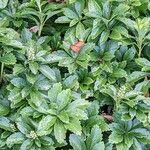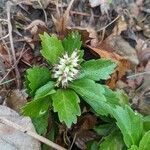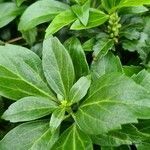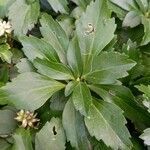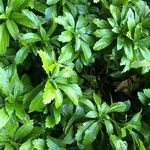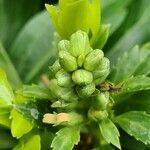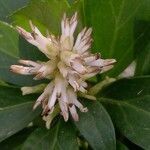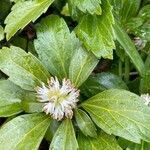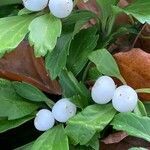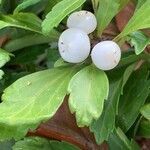Subshrubs; stem slightly thick, puberulent, lower part rhizomatous, ca. 30 cm, prostrate, curved, or obliquely ascending, with densely fibrous adventitious roots, upper part erect, ca. 30 cm tall, leafy. Leaves at intervals of 2-4 cm on stem or 4-6 leaves close to each other; petiole 1-3 cm; leaf blade rhombic-obovate, 2.5-5(-9) × 1.5-3(-6) cm, leathery, puberulent along midrib adaxially, base attenuate into petiole, margin dentate toward apex. Inflorescences terminal, 2-4 cm, erect, rachis and bracts glabrous. Flowers white. Male flowers more than 15, inserted on almost all rachis, sessile; bracts and tepals broadly ovate, bracts small, tepals 2.5-3.5 mm; filaments ca. 7 mm; sterile pistil ca. 0.6 mm. Female flowers 1 or 2, inserted basally on rachis or sometimes solitary apically in 1 or 2 leaf axils, flower and pedicel ca. 4 mm; bracts and tepals ovate, imbricate; styles exserted after pollinated, apex convolute. Fruit ovoid, 5-6 mm; persistent styles thick and reflexed, 5-10 mm. Fl. and fr. Apr-May.
More
A small evergreen shrub 20 cm high. It spreads to 50 cm across. Leaves are glossy dark green. They are clustered at the tips of the short stems. The upper half of the leaves are often toothed. Plants are separately male and female so both are required for fruit production. The flowers are small and greenish or white and without petals. The flowers have a pleasant sweet smell.
With narrower lvs, terminal infls, and bicarpellate, baccate white fr 6–7 mm, sometimes escapes.
A temperate plant. It grows in moist deciduous woods in valleys and low mountains to 2000 metres. It can grow in shade. It needs moist well drained soil. It does not do well in full sun, dry soils or in windy locations. It can stand frost. Melbourne Botanical gardens. It suits hardiness zones 5-10.
More
Moist deciduous woods in valleys and low mountains to 2000 metres.
